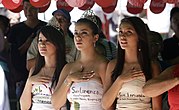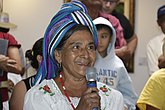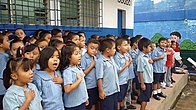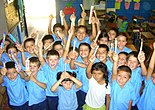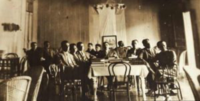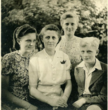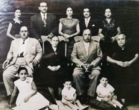Demographics of El Salvador
Due to its approximate demographic density of 321.55 inhabitants/km² (one of the highest in the world), it is the most densely populated sovereign country in the Americas, excluding the Antilles archipelago. However, El Salvador has the highest population growth low in Central America, and its population will begin to fall due to the reduction in the fertility level and an aging process, the decrease in the population of El Salvador will be the highest in Latin America and in the world, similar to countries like Japan or Spain, and will pass Being the least populated country in the Central American isthmus, currently the average age of El Salvador is the longest in Central America, however in 2100, the average age of the country will be 50.55 years, the third highest and longest in America latina
The metropolitan area of San Salvador has a population of 2,820,710 inhabitants, which is equivalent to about 27% of the total population. Approximately 35% of the Salvadoran population lives in rural areas. The official entity in charge of demographic records and studies is the General Directorate of Statistics and Censuses (DIGESTYC) of the Ministry of Economy.
Population
Total population
6 550 396 (2022)
Projections
- Year 2030: 6 778 591
- Year 2040: 6 931 496
- Year 2050: 6 936 792
- Year 2060: 6 785 672
- Year 2070: 6 473 698
- Year 2080: 6 005 535
- Year 2090: 5 409 352
- Year 2100: 4 766 079
Source: El Salvador - Population 1950 - 2100
Demographic evolution
Demographic history
The first population census in El Salvador was carried out in 1930.
| Year of the Census | Total (Writers) |
|---|---|
| El Salvadoran Census of 1930 | 1 434 361 |
| El Salvadoran Census of 1950 | 1 855 917 |
| El Salvadoran Census 1961 | 2 510 984 |
| Census Salvadoran of 1971 | 3 554 648 |
| 1992 Salvadoran census | 5 118 599 |
| 2007 Salvadoran census | 5 744 113 |
Aging
Currently, El Salvador is the oldest nation in Central America, and one of the oldest in Latin America. The aging process is mainly due to the drop in the fertility rate, from 3.5 children per woman in 1998 to 1.8 children per woman in 2015, and the country is now the country with the least demographic growth (0.4% annually). Before the 1980 Civil War, El Salvador had the second highest growth rate in Central America, second only to Guatemala. The low rate of growth and the emigration of Salvadorans abroad affected the population growth of the country; According to some projections made in the country, El Salvador will grow with less than 30,000 people annually from 2030; This growth will reach its peak in 2050 with 6,825,935 inhabitants, remaining stable throughout that decade and from the 2070s it will begin to decrease with -0.2% annually, then by 2080 with -0.7% annually, by 2090 with -1.9% annually and by 2100 with -4.6% remaining. Costa Rica also follows the same pattern, although with a decrease from a previous decade and with larger subtractions. If the projections are accurate, the country would go from being one of the most populous to one of the least populated on the isthmus.
By 2021, the average age of El Salvador is 31.8 years old, according to experts, the fertility rate per woman in El Salvador has stagnated at 1.7 children, this indicates that the population over 65 years of age has a superior and accelerated growth, by the year 2100, the average age of El Salvador will be 50.55 years of age, the third highest and longest-lived in Latin America.
| Year | Population over 65 | Percentage |
|---|---|---|
| 2000 | 330.448 | 5.6 per cent |
| 2025 | 797.441 | 11.3% |
| 2050 | 1,900,000 | 24.1% |
Ethnic Composition
| Ethnic groups in El Salvador (CIA Factbook) |
|---|
| Mestizos (86.3%) White (12.7%) Indigenous (0.2%) Asian (0.8%) |
| Ethnic groups in El Salvador |
|---|
| Mestizos (68%) Whites (15%) Indigenous (8%) 2 per cent |
The ethnic composition of El Salvador is the way in which the population of that country is constituted racially and anthropologically. The primordial nucleus is a miscegenation between three fundamental roots: indigenous, Spanish and the black that was later enriched by the immigration of Spaniards, Italians and Arabs. El Salvador has a homogeneous mestizo, white and mulatto population with indigenous, Arab and Asian minorities.
| Ethnic composition 1750-1930 - El Salvador | |||
|---|---|---|---|
| Year | Mestizo % | % | White % |
| 1750 | 40.0 | 50.0 | 10.0 |
| 1805 | - | 22.0 | - |
| 1821 | - | 22.0 | - |
| Ethnic composition of the population in censuses since 1750-1930 | |||
Mestizo Salvadorans
Mestizos appeared shortly after the arrival of Europeans on the American continent, when the shortage of white women caused the conquistadors to have sexual relations with indigenous women. After the implementation of the caste system, a multitude of terms appeared to describe mestizos according to the amount of European or indigenous blood they had. The first-generation mestizo was called clean mestizo or good mestizo, which were the product of the union of a Spaniard and a mestizo, castizo, and the one who was from the union of a mestizo and an Indian woman, coyote. From a coyote and an Indian woman was born a chamizo jumps back and from a Spaniard and a castiza, another Spaniard, since unlike African blood, indigenous blood could be "cleaned". The mestizos occupied an intermediate place in the social pyramid of the colony, below the Spanish and Creoles, but above the indigenous and blacks.
In the early years of the colonial era, the mestizo, mulatto and white population already represented half of the population; in 1821, the mestizo, brown and white population represented 78%.
Today, mestizos are the largest ethnic group in El Salvador, including browns, undomestizos, and whites who identify as mestizos
Today, many Salvadorans culturally identify as part of the majority Salvadoran mestizo population, even if they are racially European (especially Mediterranean), as well as indigenous peoples in El Salvador who do not speak indigenous languages or have an indigenous culture, and tri-racial/brown Salvadoran or Salvadoran Arab. The Salvadoran mestizo culture quickly became the most successful and dominant culture in El Salvador. This has made El Salvador one of the most mixed nations in the world.
Native American Salvadorans
It is estimated that before the arrival of the Europeans there were 500,000 natives in El Salvador.
After the arrival of the Spanish conquistadores, the indigenous population was drastically reduced due to epidemics and warfare. The caste system assigned indigenous people the lowest place on the social scale, only above individuals of African origin. However, the indigenous ruling class continued to enjoy certain privileges (for example, the caciques held the dignity of hidalgos).
Currently, the native population is very small and represents 8%, most of them are concentrated in the west and speak Spanish as their mother tongue and Nahua as a second language.
The largest and most dominant native Salvadoran groups in El Salvador are the Lenca and Pipil peoples, followed by small enclaves of Mayan peoples: (Poqomam/Ch'orti'), Cacaopera, Xinca people, Alaguilac, Mixe people, Chorotega, as well as an Olmec past. (Pipil, located in the west and center of the country, and Lenca, located east of the Lempa River). There are small cocoa populations in the Department of Morazán and a few Ch'orti' They live in the department of Ahuachapán, near the border with Guatemala.
White Salvadorans
After the conquest of the native population, the Spanish established a caste system in which they and their descendants occupied the top of the social pyramid. However, the Spaniards born in America (Creoles) played a secondary role within the system, with the peninsulares being those who had the right to high political, religious and military positions. It is for this reason that it was the Creoles who initiated the independence movements at the beginning of the XIX century. In 1790 there was a growth of the Creole population because many poor families from Galicia began to migrate to El Salvador, when El Salvador became independent. The Creole population was very scarce, there were only 50,000, which represents 20%. In the following years migration has been present beginning with the Sephardic Spanish immigration and Spanish immigration in El Salvador followed by refugees from the First and Second World War.
There are currently Salvadorans of ancestry from Spain, Italy, France, Portugal, Germany, England, and Ireland, most Salvadorans with Mediterranean features identify as mestizos because they assimilated into the culture of El Salvador.
Following the Civil War in El Salvador, many upper-, middle-, and lower-class white Salvadorans migrated to the United States. According to the United States Census Bureau, 40.5% of Salvadorans living in the United States declared themselves white in 2010.
Salvadorans of Spanish origin
The Spanish began settling in El Salvador in the mid-1520s. 12.7% of Salvadorans are white.
This population is made up of those of Spanish origin, while there are also Salvadorans of French, German, Swiss, English, Irish, and Italian descent. Most of the Central European settlers in El Salvador arrived during World War II as refugees from the Czech Republic, Germany, Hungary, Poland, and Switzerland, and many settled in the region that is now Chalatenango by the turn of the century XVIII.
In 1789, Francisco Luis Héctor de Carondelet was appointed governor of El Salvador. Because the local indigenous population working in the indigo industry had greatly diminished, Carondolet recruited Spanish laborers from northern Spain to settle in El Salvador. In 1790, Francisco Luis Héctor de Carondelet ordered families from northern Spain (Galicia, Asturias, the Basque Country, Cantabria and Navarra) to settle in the area to compensate for the lack of indigenous people to work the land; The important settlements of these Spaniards were the northern and central parts of El Salvador. Their descendants are among the blond and light-skinned people of the present-day department of Chalatenango.
During 1880 to 1920, El Salvador had its Migration Peak of Immigrants from Europe, as well as immigrants from nearby countries, Asians and other North Americans, when more than 120,000 arrived in El Salvador, the demographic weight was unprecedented, in 1880 the Population was 480,000 inhabitants and by 1920 it was already 1,170,000. the main groups were the Spanish, Italians, Germans and some French, Polish and British.
Salvadorans of French origin
French immigration to the Republic of El Salvador was an important movement that the country received between the 19th century and the middle 20th century, between 1850 and 1870. The French formed the largest foreign group in El Salvador, later in 1940 to 1950 they formed one of the largest groups in the country, second only to the Spanish and Italians. Between 1850 and 1870, El Salvador was the main recipient of the French in Central America, most of whom were merchants and businessmen with their families.
It is estimated that between 1850 and 1950 more than 7,000 French emigrated to El Salvador, most of them came from Aquitaine, Occitanie and the Alps, between 1850 and 1870 2,000 French arrived in El Salvador, between 1911 and 1937 they entered the country 2,000 French, finally in 1938 to 1945 2,500 French entered the country, French immigration at that time greatly influenced the economy and education.
Since the Colonial Period there has been a record of Frenchmen in Salvadoran territory, in which several French corsairs and French pirates stand out. In 1850, several French businessmen and merchants left for El Salvador to work in different trades such as trade, planting sugar. cane, industry and cultivation of coffee, during that time 2,000 Frenchmen arrived in the territory, the majority were wealthy families and merchants. Most of the French who would arrive between 1880 and 1910 were merchants and professionals, but from 1911 to 1937 immigration would shine again for various reasons. Many businessmen and merchants arrived in Salvadoran territory, at that time the French investment in El Salvador was equal to that of the United States, during that period of time or, 2,000 French entered El Salvador. According to historical records, the French were the third group of foreigners in the country, only surpassed by Spaniards and Italians.
Most of the French who arrived in the national territory came first from Corsica later in 1850 to 1950, most of the French who arrived in the territory were from Aquitaine, Occitanie and Rhône-Alpes but also Paris and other parts of the Alps, most of the French settled in San Salvador, however the City of Santa Tecla in the Department of La Libertad (El Salvador) historically received a large number of French immigrants, other places with significant numbers are Santa Ana and Antiguo cuscatlan.
Salvadorans of German origin
German immigration to El Salvador was a migratory movement, which began between 1880 and 1840 when the largest influx of Germans was recorded. The first Germans in El Salvador joined their mostly wealthy families in 1870 and established cafeterias. At that time El Salvador had implemented the liberal reforms which attracted thousands of immigrants from Europe, the Middle East and Asia as well as German immigration into the country, more families immigrated to El Salvador and agricultural land was also distributed. The main settlements of these families were the coffee growing areas and also large cities such as Nueva San Salvador now known as Santa Tecla, San Salvador, Department of Chalatenango, Cuscatlán, Department of Usulután and other areas where German immigrants saw economic opportunities in the country, they excelled in industry, commerce and agriculture.
One of the most famous Germans to immigrate to El Salvador was Walter Thilo Deininger, who moved to the department of Cuscatlán in 1885. He soon built his coffee farm and other industries. Shortly after, more German families arrived in the Department of Cuscatlán, El Salvador, as well as important figures such as Jürgen Hübner, German historian and author of "Die Deutschen und El Salvador (The Germans and El Salvador).
By 1890, Germans were one of the largest immigrant groups in the country and were able to establish themselves and stand out from the crowd of other European immigrants. The number of Germans in El Salvador then increased, their descendants far outnumbering the number of German immigrants living in El Salvador. There were cities founded by German families, such as Berlin, Usulután, which is a very clear example of a settlement founded by a German. Later other German families arrived in the area. To the north of El Salvador, specifically what is now north of Metapan and Chalatenango, there were German settlements.
The department of Usulután was the area with the greatest presence of Germans in El Salvador. The Germans began arriving in the early 20th century century and settled to produce coffee.
The book “The Population of El Salvador”, by Rodolfo Barón Castro, published in 1942, shows one of the first Statistical Censuses published by the Central Directorate of Migration in 1937; there he indicated that the four largest groups of immigrants in El Salvador, at that time, were made up of Spaniards, Palestinians, Italians and Germans. The Germans arrived in the country in the early 1900s and, along with Italians, French and other Europeans, helped develop roads, build the Port of Puerto El Triunfo.
In addition, from the municipality of Berlin, Usulután there was a direct route to get to Puerto El Triunfo; an ideal route to transport the goods they produced and obtain work materials.
It was the meeting point where the descendants of Germans and those close to Germany met to do their business because the farms were somewhat far away. They found in this part of El Salvador a center of excellence to live or develop, but they also needed to have a place to meet on weekends, to go and talk, which is typical of the cultures of these towns: to have a meeting point. ”
The settlement was also agricultural, in 1958 the German Embassy in El Salvador founded the "Círculo Cultural Salvadoreño-Alemán", (German-Salvadoran cultural circle) to promote cultural exchange between Germany and El Salvador. The German School was inaugurated on March 3, 1965, the Salvadoran German Cultural Forum has been held every second Friday of November since 2006 Gardens of the Hilton Princess Oktoberfest Hotel. More than 700 people/families participate in a typical German dinner, German music and a typical German parade enjoying costumes. The traditional "Beer Festival" will continue thanks to the sponsorship of La Constancia and organized by German companies. In the city of San Salvador since 2011 in the third week of October the Oktoberfest Pilsener is celebrated in the exhibition and congress center. More than 27,000 people attended the 2013 edition, which became the largest Oktoberfest in Central America. During four days of festivities, participants enjoy traditional German cuisine and music, as well as a great selection of beers, some of which are brewed exclusively for the event.
Germany is one of the main trading partners of the European Union of El Salvador and is the largest importer of Salvadoran coffee. The German-Salvadoran Chamber of Commerce is made up of around 85 companies. In addition to a German school in San Salvador.
Salvadorans of Italian origin
Italian immigration in El Salvador refers to the movement of Italians to the Republic of El Salvador and one of the most historically important movements in El Salvador. Italo-Salvadorans are one of the largest European communities in the country, and one of the largest in Central America and the Caribbean, as well as one of the most socially and culturally important in the Americas.
Mid-century 19th century to mid-century XX waves of Italian immigrants were registered and arrived from all regions of Italy, mainly Northern Italy and Southern Italy, the first Italians to arrive in the country were mainly from the Kingdom of Sardinia and Piedmont, and also from the Kingdom of the Two Sicilies, which include several Italians from different cities and provinces, since 1880, there has been a flow from all Italian regions but mainly from the south of the peninsula highlighting regions such as Campania, Basilicata, Apulia and Sicily.
There is a record of Italians residing and arriving in the country since 1850, who came from the Kingdom of Sardinia-Piedmont and the Kingdom of the Two Sicilies, various intellectuals, merchants and other lower middle classes. The Italians stand out, during those years several ships arrived in the country mainly from important Italian port cities, among which are Naples, Genoa and Palermo, most of these Italians entered through the port of the Department of La Libertad (El Salvador). and in the East of the country, during that time the Italians in the country did not exceed 2,000, however in the following years the number of arrivals would grow more.
By 1870, more ships arrived from Naples and Genoa, between 30 and 60 Italian immigrants, but many merchants were also entering the country every day. During that period of time, the country created very free immigration reforms, which attracted more immigrants from the world, many Italians arrived between 1876 and 1879, several ships to the country, mainly from Campania and Liguria, between 1870 and 1879, were It is estimated that more than 2,500 Italians entered the country. At that time, El Salvador was the main recipient of Italians in Central America, attracted mainly by various agricultural opportunities. In 1880 to 1889, more than 2,000 Italians, mainly from Campania and Piedmont, arrived in the country. Many boats of more than 100 Italian immigrants arrived at the Salvadoran coast. These boats set sail from Naples. and Liguria, this time it was highlighted by the arrival of lower class Italians and some professionals, however, there were also nuns and priests who came to the country to found various important churches, schools and organizations. In 1890 Italian immigration grew exponentially, it is estimated that between 1890 and 1899 more than 6,500 Italians arrived in the country, the vast majority arrived at the port of the Department of La Libertad (El Salvador), several architects and other Italian professionals arrived, such as those who They built the Santa Ana Theater.
In 1890, many Salesians from Turin arrived in the country, sailed in ships full of Italian immigrants and arrived at the port of the Department of La Libertad (El Salvador). Many stayed in the city of Santa Tecla, where they founded various organizations and schools like the Santa Cecilia School, which was founded in 1899 by Italians.
In 1898, the first Italian organization in El Salvador and the first in Central America was founded, the Society for Assistance and Charity among Italians in El Salvador, known as Italian Assistenza. The objective of this organization is to help newly arrived Italians to get a job and help them financially while they got it.
20th century
The era was characterized by the massive entry of Italians into the country, between 1900 and 1909 more than 10,000 Italians from all Italian regions arrived in the country, at that time, El Salvador was the second largest recipient of Italian immigrants in Central America, many looking for better opportunities for their businesses and improve their quality of life, where several merchants and Italians who enter the country stand out, many standing out in areas such as Education, Music, Agriculture, Industry, Commerce and infrastructure.
Between 1910 and 1919, thousands of other Italians entered the country since they registered more than 6,000 arrivals in the country, the Italians easily adapted to the country and more Italians arrived in the country every day, El Salvador at that time managed to reach the main recipient of Italians in Central America, between 1920 and 1929 several Italian merchants and professionals arrived, but also lower-class Italians, many set up their businesses, in 1930 Italian immigration was paralyzed for various reasons, between 1930 and 1939, it is estimated that more than 1,000 Italians arrived to the country and many set up their businesses.
In 1940, due to the Second World War, a great migratory wave of thousands of Italians began to emigrate to the country, where several merchants and Italians stood out who wanted to improve their quality of life. This period was characterized by the entry of several refugees. and Italians, most of whom came from northern Italy.
Between 1960 and 1980 several Franciscans arrived in the country, many founded schools and organizations to help the Salvadoran people, and also to reactivate Italian culture in the country.
In 1989 a son of Italians, Alfredo Cristiani, was elected president of El Salvador. After five difficult years, his term ended in 1994, leaving his nation stabilized from the civil war that had plagued it for 20 years.
Italian immigration to El Salvador was a very large movement that the country received, from 1850 to 1929, it is estimated that more than 32,000 Italians arrived in the small country, in search of job opportunities and improvements in their quality of life, but the migratory peak It was between 1880 and 1930, when thousands of Italians from all regions arrived in El Salvador. The main recipients of Italians in America were the United States, Argentina, Brazil, Uruguay and other countries in the region, although El Salvador received large amounts of Italian and American immigrants is one of those that has had the most social and cultural weight.
Italian immigrant occupations and age
Italians who arrived in the mid-19th century were mostly poor or middle class, many were farmers and workers who came to the country to look for work, several merchants also arrived, according to some records, the Italians who arrived in the country between 1850 and 1870, were many families, who on average were between 22 and 26 years old, plus 60% of immigrants who arrived in the country were men and 40% women.
From 1870 to 1879, 2,500 Italians arrived in the country, 63.5% were men, the average age was around 20 to 30 years and the majority were merchants, workers and farmers, between 1880 and 1889 around 2,000 emigrated to the country Italians, 64% male and 44% female, the age varied widely, from 2 years to 50 years, the majority being merchants, laborers and farmers, with an increasing arrival of priests, nuns and preachers. Between 1890 and 1891 the second highest peak was recorded, when 6,500 Italians entered El Salvador, the average age was around 20 to 30 years, and the most numerous occupations were merchants, workers, farmers, priests, nuns, teachers. and architects. The highest peak of Italian immigration in the country occurred between 1900 and 1909, when 10,000 Italians emigrated to the country in search of a better future, 60% were men and 40% women, and the average age was around 20 years. 30 years of age, the most numerous occupations were workers, merchants and some teachers, from 1910 to 1919 more than 6,000 Italians entered El Salvador, this year is distinguished by a growth of immigrants who are women with around 43% and 57 % are men, the age varies between 3 years to 50 years, later, between 1920 to 1930, the majority that arrived in the country was dedicated to commerce, agriculture and other businesses and activities.
Italian settlements in El Salvador
The first Italians to enter the country settled in Santa Ana and the Department of San Miguel (El Salvador). Others settled mainly in the eastern part of the country, in the Department of San Miguel (El Salvador), Usulután and the Department of La Unión. In the north of the country, in the Department of Chalatenango, several groups of Italians also settled.
The Italians from the south settled mainly in the Department of San Miguel (El Salvador), Santa Ana, San Salvador and other departments of the country, where several cities stand out, Santa Tecla was the one that received the greatest demographic weight due to the Italian immigration, since it became the capital various Italian communities arrived.
The Lucanos, Campanos, Sicilians, and Pullese had their main destinations in San Salvador, Santa Ana, and the Department of San Miguel (El Salvador), while the Italians from the north: the Venetian, Ligurian, and Lombard Piedmontese settled mainly in Department of La Libertad (El Salvador), San Salvador, Chalatenango, Santa Ana and Department of San Miguel (El Salvador). Several Italians settled in the department of Sonsonate, particularly from Castelnuovo di Conza in the Campania region, and Usulután received several Italian farmers from northern Italy, also in La Unión where several southerners and northerners settled, mainly Piedmontese and Calabrian. Minority but visible groups of Italians settled in the other departments of the country. success in trade and agriculture.
Salvadoran Arabs
There is a significant Arab population (approximately 120,000); mainly from Palestine (especially from the Bethlehem area) but also from Lebanon, Morocco and Syria. Salvadorans of Arab descent number around 100,000 people, while Salvadorans of Lebanese descent number around 25,000.
The history of the Arabs in El Salvador dates back to the end of the XIX century, when religious conflicts in the Empire Ottoman induced many Palestinians, Lebanese, Egyptians, Tunisians, Algerians, Iraqis, Omanis, Saudis and Syrians to leave the land where they were born and travel to El Salvador in search of a place where they could live in relative peace. For similar reasons Christian Turks and Persian peoples from Turkey, Iran, and Afghanistan also arrived in El Salvador at about the same time. There were also economic factors that contributed to immigration from the Middle East; many immigrants felt that they could achieve success abroad at a level that they could not in their home countries.
The first wave of Arab migration to El Salvador began between 1880 and 1920, amid a large influx of immigrants into the country. These Arabs settled in the cities of San Salvador, San Miguel, Santa Ana, Santa Tecla, Usulután and La Unión.
El Salvador's population increased from 482,400 in 1879 to 1,168,000 in 1920, with immigration, including immigration from the late Ottoman Empire, driving growth substantially.
Arab immigration into El Salvador began at the end of the 19th century as a result of the repressive policies applied by the Ottoman Empire against those of the Maronite Catholic Church. Several of the destinations that the Lebanese chose at that time were in countries of the American continent, including El Salvador. This resulted in the residents of the Arab diaspora being characterized by being forged in devout Christian families and very attached to their beliefs, since in these countries they can exercise their faith without fear of persecution, which resulted in the rise of the Lebanese peoples. -Salvadoran, Syrian-Salvadoran and Palestinian-Salvadoran Communities in El Salvador.
Currently, the Palestinian community forms the largest Arab diaspora population in El Salvador, with 70,000 direct descendants, followed by the Lebanese community with more than 27,000 direct descendants. Both are made up almost entirely of Catholics and Eastern Orthodox churches. The killing of Lebanese Arab Christians and Palestinians at the hands of Muslims initiated the first Arab migrations to El Salvador.
Inter-ethnic marriage in the Lebanese community with Salvadorans, regardless of religious affiliation, is very high; most have only one Lebanese father and Salvadoran mother. As a result, some of them are fluent in Arabic. But the majority, especially among the younger generations, speak Spanish as their first language and Arabic as their second.
During the 1948 Israel-Lebanon war and the Six-Day War, thousands of Lebanese left their country for El Salvador. Many arrived in La Libertad, where they comprised half of the economic activity of the immigrants.
Lebanon had been an iqta of the Ottoman Empire. Although the imperial administration, whose official religion was Islam, guaranteed freedom of worship for non-Muslim communities, and Lebanon in particular had a semi-autonomous status, the situation for practitioners of the Maronite Catholic Church was complicated, as they had to pay exaggerated taxes and were limited by their culture. These tensions were expressed in a rebellion in 1821 and a war against the Druze in 1860. The hostile climate caused many Lebanese to sell their property and take ships in the ports of Sidon, Beirut, and Tripoli for the Americas.
Arab-Salvadorans and their descendants have traditionally played an important role in the economic and political life of El Salvador, with many becoming notable business leaders and political figures.
In 1939, the Arab community based in San Salvador organized and founded the "Sociedad Unión de la Juventud Árabe"
Salvadoran Jews
Representation of documents that were delivered to a Jewish family in Central Europe. Most of the Jews who came to El Salvador were from Germany, Poland, Hungary and Switzerland. 40,000 people were saved with Salvadoran citizenship documents such as these, given by Arturo Castellanos and José Gustavo Guerrero
There is a small community of Jews who came to El Salvador from France, Germany, Morocco, Tunisia, and Turkey. Ashkenazi Jewish refugees also arrived during World War II:
Since colonial times, there is a record of Jews in Latin America, in El Salvador there is a record of various Jewish immigration from Portugal, after the independence of El Salvador, it is believed that the first Jewish immigrant was Bernardo Haas, born in Alsace. Subsequently, the first documented German Jew arrived in the country in 1888, according to academic Jessica Alpert. France and Central Europe were the main countries of origin of this contemporary Jewish migration, the majority being Ashkenazi and Sephardim, they stayed permanently in El Salvador.
The immigration laws of El Salvador were very free between 1821 and 1930, however they changed after 1930, but these strict laws culminated in 1940, during the Second World War several Ashkenazi Jewish refugees arrived mainly from Hungary, Germany, Poland, Switzerland, Slovakia and France, giving them several Salvadoran nationality documents.
Currently the Jewish community in El Salvador is quite small, however there are a considerable number of descendants and they have stood out in society, as are several businessmen and politicians of Jewish origin, such as Ernesto Muyshondt.
Gypsies in El Salvador
Gypsy caravans in El Salvador in the 20th century. The city of Santa Tecla was one of the places where there were gypsy camps in El Salvador in the first decades of the XX century. On May 7, 1926, the newspapers of the city of San Miguel, El Salvador reported that within its urban area there was a nomadic community of gypsies, who were also called Hungarians or Magyars (for Magyar or Hungary). area to which they belonged at the time) believed they were natives), gypsies or "peroleros", a name due to the enormous pots or pans that they always carried in their wagons and with which they prepared communal meals among enormous woodcutters. stoves on.
In 1929, the writer Francisco Miranda Ruano would remember "The tired gypsies of that day" of his distant childhood and whose adventures opened his vocation as a writer. The spread of Theosophical, Fascist, and National Socialist ideas among the military and civilians in El Salvador in the 1920s and 1930s created an adverse environment for the periodic arrival of the Gypsy people in El Salvador. The maximum expression of this mental and cultural confinement occurred during the dictatorial government of Brigadier Maximiliano Hernández Martínez, who issued the Migration Law that prohibited the entry into the country of blacks, Arabs, Turks, Chinese and gypsies. This makes the gypsies in El Salvador hide their identity.
The Roma Holocaust in Nazi Europe from 1935 to 1945 killed thousands of Roma. Some of them were able to save themselves from that sad fate, thanks to the thousands of Salvadoran nationality certificates issued, in a clandestine operation, by the Salvadoran consul in Geneva, Colonel Arturo Castellanos, José Gustavo Guerrero and his Jewish secretary from Transylvania, George Mandel- Keep it.
In the 1980s, the writer Claribel Alegría included in her novel Alicia en el país de la realidad the character "La Gitana", who functioned as a rebellious and feminist conscience within the literary structure of the work. At the same time it turned out to be a tribute to the gypsy caravans that once passed through Santa Ana, Sonsonate, Nahulingo, Usulután, Santiago de María, Chalatenango, San Miguel, El Salvador, La Unión and many towns, streets, cities and other local territories. From El Salvador.
More than eight decades after such terrible racist legislation, the Romani language is no longer heard in Salvadoran territory. In the Romani language, the father of the family is called "Shero Rom", and it is theorized that this could be the origin of the Salvadoran word "Chero" to designate a friend.
Salvadorans of African origin
Afro-Salvadorans, called Pardo (caste) and sometimes Afro-mestizo in colonial times, are descendants of the African population that was enslaved and sent to El Salvador to work in mines in specific regions of El Salvador. They have mixed with and were naturally absorbed into the general mixed race population, which is a combination of a mixed race majority and a minority of African descent, which are racially mixed populations. Thus, there are no significant extremes of African physiognomy among Salvadorans as there are in the other Central American countries. A total of just 10,000 African slaves were brought to El Salvador over a span of 75 years, beginning around 1548, some 25 years after El Salvador's colonization. El Salvador is the only country in Central America that does not have populations of English West Indians (West Indians) or Caribbean Garifuna, but instead had older colonial African slaves who came directly from Africa. This is the reason why El Salvador is the only country in Central America that does not have a Caribbean culture, and instead retains its classical Central American culture.
Genetic makeup
The genetic study of the publication "Genomic Components in America's demography", in which geneticists from all over the continent and Japan participated, found that the average genetic composition of the average Salvadoran is:
| Country | European sport | African sport | Amerindian sports |
|---|---|---|---|
| El Salvador | 52% | 8% | 40% |
In 2008, Oliveira Godinho, from the University of Brasilia, carried out the study O impacto das migrações na constituição genetica de populações latino-americanas, an analysis of genetic compilations defined in different Latin American countries, obtaining the following results for Central America:
| Country | European sport | African sport | Amerindian sports |
|---|---|---|---|
| El Salvador | 15.1 per cent | 9.7% | 75.2 per cent |
In 2016, the study Admixture in the Americas Regional and National Differences was carried out, which showed the following results:
| Country | European sport | African sport | Amerindian sports |
|---|---|---|---|
| El Salvador | 46% | 10% | 44% |
The study Admixture and genetic relationships of Mexican Mestizos regarding Latin American and Caribbean populations based on 13 CODIS-STRs found that the genetic admixture of some Central American countries was as follows:
| Country | European sport | African sport | Amerindian sports |
|---|---|---|---|
| El Salvador | 51.7 per cent | 6.3% | 42% |
Languages
All the inhabitants of El Salvador speak Spanish, although English is increasingly spoken and it is estimated that half of the population knows English,[citation required] due in large part to the boom that the country has had in terms of companies that require bilingual people (Spanish-English), in addition to the fact that it is almost indispensable in many areas of study; Other languages that have become relevant in recent years due to the communities of resident foreigners are German, French and Japanese.[citation required]
Religion
According to a Public Opinion study carried out by the José Simeón Cañas Central American University (UCA) in 2008, half of the Salvadoran population professes the Catholic religion (50.4%), followed by Protestants, mostly Pentecostals, Assembly of God, Baptists, among others with 32.9%, 3.1% correspond to other religions and 13.6% have no religious identification.
A population survey conducted by UCA in 2019 revealed that 41.3% are Catholic, 37.2% Evangelical, 2.8%, and 18.7% are none/atheist or agnostic. and according to the Latino Barometer survey 39% are Catholic, 29% are Evangelical, 2% are other religions and 30% none, atheist or agnostic.
CIA World Factbook Statistics
- _
- Men: 3,382,839
- Women: 3.565,234
- 0-14 years: 36.1% (men 1,281,889/women 1,228,478)
- 15-64 years: 58.7% (men 1,942,674/women 2,134,154)
- 65 years and more: 5.2% (men 158,276/women 202,602) (2007 est.)
- Population Growth Rate:
- 0.67% (2021 st.)
- Nativity rate: (2020 est.)
- 18/1,000 inhabitants
- Mortality rate:
- 5.6 deaths/1,000 people (2003 est.)
- Proportion of Men and Women:
- At birth: 1.05 men/women
- Under 15: 1.04 men/women
- 15-64 years: 0.9 men/women
- 65 years and more: 0.83 men/women
- Total population: 0.95 men/women (2003 est.)
- Infant Mortality Rate:
- 22.58 deaths/1,000 live births (2007 est.)
- Life expectancy at birth:
- Total population: 71.78 years
- Men: 68.18 years
- Women: 75.57 (2007 est.)
- Total fertility rate:
- 3.08 children per woman (2007 est.)
- Nationality:
- Substantive: Salvadoran
- Adjective: Salvadoran
- Literacy:
- Definition: At the age of 10 you can read and write, although a illiteracy rate of 30% of the total population of the country persists, while still a goal of education is to literacyize illiterate social groups.
- Total population: 80.2%
- Men: 82.8%
- Women: 77.7% (2003 est.)
- Middle Ages:
- 27.7 years (2007 est.)
Migration
Emigration
After the Salvadoran Civil War of 1980, it caused a massive exodus of Salvadoran emigrants in search of refuge, particularly in nations such as the United States, Canada, Spain, Guatemala, Costa Rica, Panama, Mexico, among other nations. By 1990, more than half a million Salvadorans were abroad, a figure 3 times higher than that of 1980. El Salvador stands out as the main expelling country, responsible for 40% of the total emigration from the subregion, which in 80% He is heading to the United States.
In 2020 there were close to 1.6 million Salvadorans living outside the country (it does not necessarily include second generation people), which represents an increase of 21.6% compared to 2010 and indicates that 19.9% of the population born in El Salvador lives in a foreign country.
Immigration
El Salvador has not been a visible recipient of immigrant flows, but it is important to refer to immigration and its trends. At the beginning of the XX century, it received migrants from Palestine, Lebanon and the immigration of Sephardic Jews from Spain, which continued with the arrival Ashkenazi Jewish refugees during World War II.
According to the 1992 population census, the total number of immigrants reached 26,000 people, which represents 0.5% of the total population of the country. The largest foreign community in the country comes from Honduras (32.8%), followed by those from Guatemala (17.1%) and Nicaragua (8.1%). Outside the subregion, those born in the United States (16.7%) and Mexico (5.1%) stand out. Outside the continent, there is a significant wave of immigrants from Palestine, Lebanon, Syria, China and Turkey.
Currently, it is estimated that more than 100,000 Hondurans, more than 100,000 Nicaraguans and more than 40,000 Guatemalans live seeking medical attention and opportunities.
Contenido relacionado
Religion in Guatemala
Subculture
October 20
